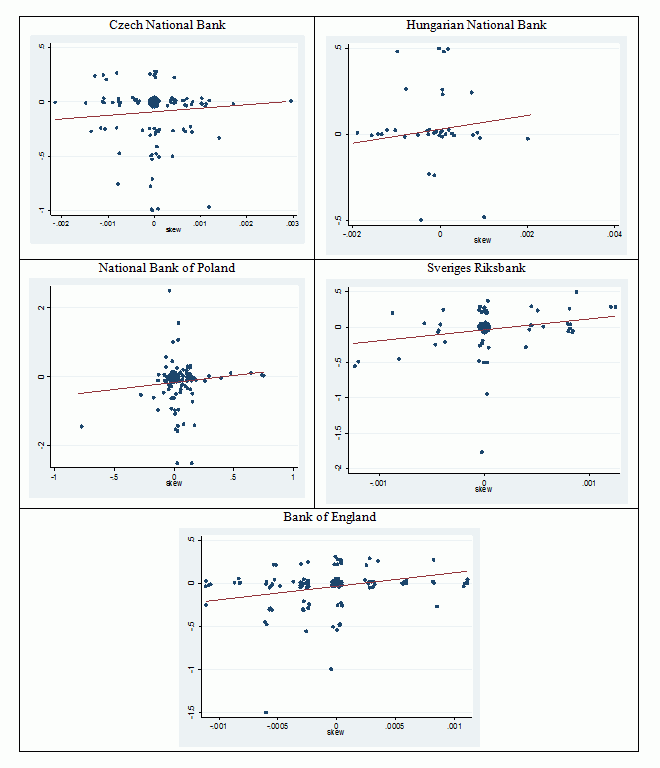Monetary-policy transparency has several dimensions, such as volume, quality, and timeliness of disclosed information. Transparency-cautious central banks typically release the voting records from monetary-policy meetings together with the minutes. Ideally, these voting records should help external observers better understand monetary policy, as argued by Geraats et al (2008) in the case of the ECB. In other words, they should be informative about future monetary policy.
In Horvath et al (2011), we collected voting record data on the central banks of six countries that decide their monetary policy by a majority vote in which individual votes are at least formally independent (the Czech Republic, Hungary, Poland, Sweden, the UK and the US). In practice, several approaches to voting are possible. Based on anecdotal evidence as well as transcripts from various monetary-policy meetings, first, each board member votes independently from others. Second, the chair of the meeting states her views first, then other members tend to follow. Third, the chair of the meeting votes last and for the sake of credibility does not enter the minority camp. It follows that only in the first case are the individual votes de facto independent. We would expect voting records to be the most informative in this case as they would reflect the information sets of all board members.
At first glance, voting data suggest that the minority votes often gave a correct signal about future monetary policy (in 71% of cases for the Czech Republic, 67% for Hungary, 64% for Poland, 80% for Sweden and 54% for both the UK and the US) – see Figure 1. At the same time, we see that the voting is often not unanimous (in 70% of cases for Hungary, 59% for the UK, 46% for the Czech Republic and Poland, 19% for Sweden). It is therefore worthwhile exploring the issue of the informative power of independent monetary-policy voting from both the theoretical and empirical perspectives in more depth.
Figure 1. Actual voting record skew and future policy-rate change
Note: Skew, plotted on the x-axis, is calculated as the difference between the average repo rate voted for by the individual board members and the actual repo rate at the next meeting. The future monetary-policy rate change is plotted on the y-axis. Jitter is used for overlapping observations for expositional purposes.
When are voting records informative?
First, we construct three different versions of a theoretical model in order to specify the conditions under which we can expect informative voting records. These three versions describe three alternative voting mechanisms that we call: (1) democratic; (2) consensual; and (3) opportunistic. In the first case, all the board members, including the chair, independently express their opinions about monetary-policy interest rates. In addition, the chair considers the votes of the other board members as being informative. In practice, this would imply that the voting record is likely to be informative, since it includes several independent information sets, one for each board member.
In the second case, the chair has a dominant position that she uses to form a consensus. In practice, this would imply that the voting record reflects fewer independent information sets and is less informative as a result, since the other board members consider the information set of the chairman superior when deciding policy, while the chair, knowing she is followed by the other board members, does not consider their votes informative.
In the third case, the chair ensures that her proposal reflects the majority view of the other board members prior to the voting. Again, the voting record in this case is less informative than in the first case, since the information set of the chair is not fully utilised.
We test the three versions of our theoretical model with simulation data in order to see how informative voting records are under the alternative voting mechanisms with additionally varying degrees of noise in information signals and overall economic volatility. We confront the three versions and the robustness tests with the above-mentioned stylised facts. In addition, we consider a third observation from the data according to which no-policy-change meetings are quite frequent, ie 69% for the UK, 66% for the Czech Republic, 65% for Hungary, 62% for Sweden, 61% for Poland and 52% for the US.
The simulation data obtained from our theoretical models show that voting records contain informative power about future monetary policy provided that there is sufficient independence in voting across board members and that the signals about the optimal policy rate are noisy. In other words, our stylised facts are best matched with the democratic version of the model. We then use real voting data to test which voting model is employed by central banks in our sample and whether the voting models applied in these central banks produce informative-enough outcomes. To be informative, the voting records must convey new information in addition to all the other information already incorporated into financial-market expectations. We find that the voting records correspond to the outcomes of the democratic version of the theoretical model. The voting records are informative about future monetary policy for all six central banks. The empirical analysis thus supports the view that the publishing of voting records improves the transparency of monetary policy.
References
Geraats, Petra, Francesco Giavazzi and Charles Wyplosz (2008)“Transparency and governance in the Eurozone”, VoxEU.org, 7 February.
Horvath, R., Smidkova, K. and J. Zapal (2011) “Central Banks’ Voting Records and Future Policy”, Working Papers 2010/11, Czech National Bank, Research Department.






